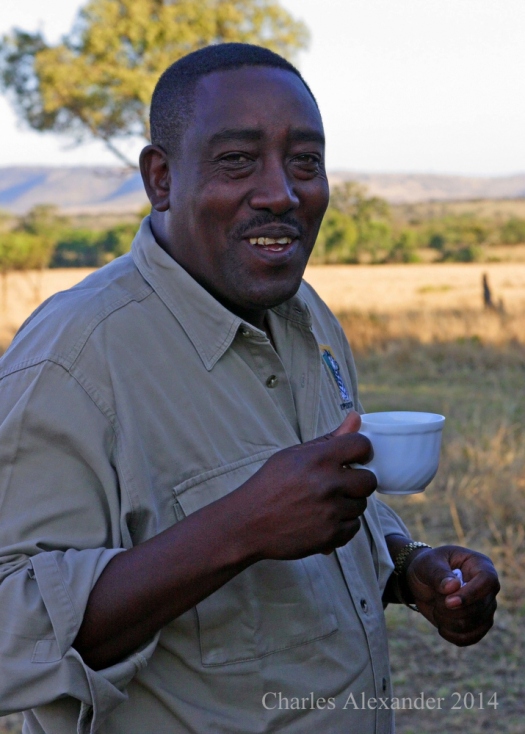Perhaps the best way to experience the African wild is to camp simply, under the stars, with the sounds of the night lulling you into dreams that cannot compare with the reality of your waking hours out on the trail. Up at 5am, breakfast before dawn, out of camp by 6. Back into camp at sunset, dinner, download the day’s reference photos, make notes in journal, off to bed.
Sleep on safari, at least for me, is just a necessary passing of the hours before sunrise. With dawn, the sweetest dream–encompassing a world of wild creatures at every turn– begins anew.
Moving the camp around as desired is a practical way to experience the best that each East African ecosystem has to offer. One of my favorite places–Tanzania’s Serengeti National Park–embraces a spectacular array of different landscapes: golden endless plains, fascinating kopje rock castles, rugged hills, and meandering rivers cloaked in woodlands. All there waiting to be explored…

I journeyed to the northern Serengeti’s Bologonja region (not far from the Kenya border) in order to retrace the steps of Stewart Edward White, an American hunter who wrote the first detailed account of the Serengeti in his book The Rediscovered Country, published in 1913.
Of this area of the Serengeti, White wrote:” Never have I seen anything like that game. It covered every hill, standing in the openings, strolling in and out among the groves, feeding on the bottom lands, singly, or in little groups. It did not matter in which direction I looked, there it was; as abundant one place as another. Nor did it matter how far I went, over how many hills I walked, how many wide prospects I examined, it was always the same. During my stay at the next two camps I looked over fifty square miles. One day I counted 4,628 head! And suddenly I realized again that in this beautiful, wide, populous country, no sportsman’s rifle has ever been fired. It is a virgin game country, and I have been the last man who will ever discover one for the sportsmen of the world. There is no other available possibility for such a game field in Africa unexplored. I moved among those hordes of unsophisticated beasts as a lord of Eden would have moved.”

 Lord of Eden! As my Tanzania driver-guide Edward and I made our way along the front lines of the Great Migration 100 years later at Bologonja, I knew exactly how White must have felt. The dust, the tumult of tens of thousands of mammals on the move, the cacophony of grunting wildebeest and braying zebras: experiencing a glimpse of the still-living Pleistocene will rock your world forever.Incidentally, many more wildebeest are alive today than in White’s era. The great herds had been decimated by rinderpest in the 1890’s and were only just beginning to recover by 1913. Now is perhaps the greatest time in history to wander among the migration– so get there, if you possibly can! As for White’s assertion that he moved among hordes of “unsophisticated beasts” while in the Serengeti, I can only say that he must not have been well acquainted with elephants! But those were the times that he lived in…
Lord of Eden! As my Tanzania driver-guide Edward and I made our way along the front lines of the Great Migration 100 years later at Bologonja, I knew exactly how White must have felt. The dust, the tumult of tens of thousands of mammals on the move, the cacophony of grunting wildebeest and braying zebras: experiencing a glimpse of the still-living Pleistocene will rock your world forever.Incidentally, many more wildebeest are alive today than in White’s era. The great herds had been decimated by rinderpest in the 1890’s and were only just beginning to recover by 1913. Now is perhaps the greatest time in history to wander among the migration– so get there, if you possibly can! As for White’s assertion that he moved among hordes of “unsophisticated beasts” while in the Serengeti, I can only say that he must not have been well acquainted with elephants! But those were the times that he lived in…

I never saw another vehicle in the vicinity of these remote Serengeti camps. And wildlife was everywhere in astonishing profusion. Lanterns are set about the perimeter of camp by night in order to discourage nocturnal predators.
 Chegge, cook at my mobile Serengeti bush campa, excelled at whipping up excellent meals under the most basic conditions. Food somehow tastes better cooked in the open.
Chegge, cook at my mobile Serengeti bush campa, excelled at whipping up excellent meals under the most basic conditions. Food somehow tastes better cooked in the open.
- ” I can’t believe we are camping here!” he shouted wryly as I snapped his photo. ” Next time, Ndutu Lodge!!”











